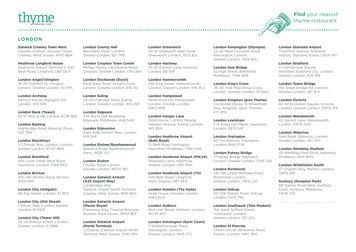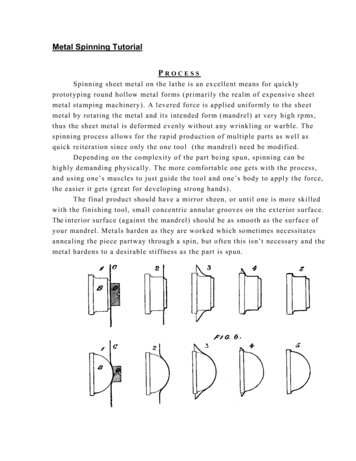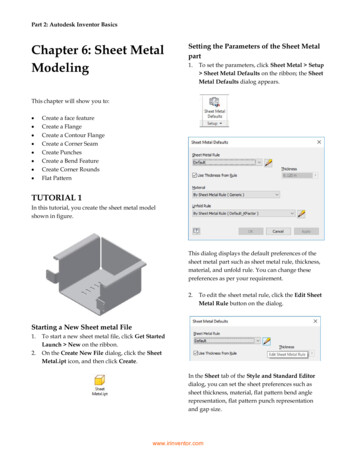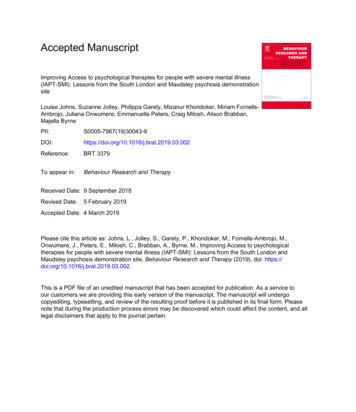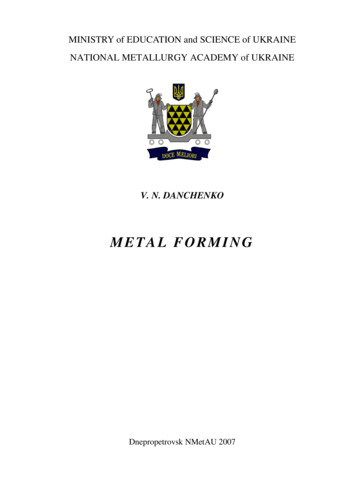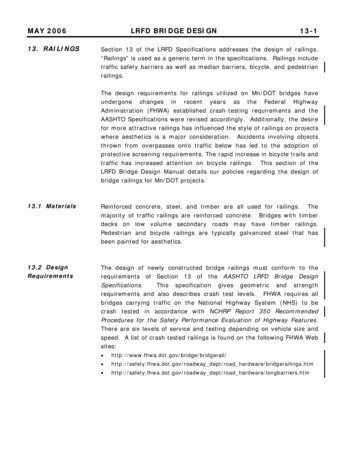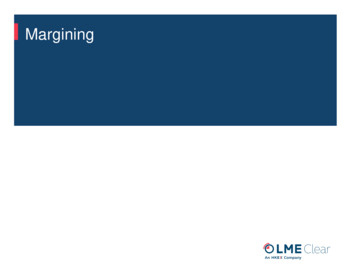
Transcription
Margining
Margin MethodologyMargin OverviewThere are two main elements to the overall margin liabilityInitial Margin “For the Clearing House to be holding sufficient funds on behalf of each Clearing Member to offset any lossesincurred between the last payment of margin and the close-out of the Clearing Member’s positions should thatClearing Member default”Variation Margin “The valuation calculation of a transaction or position is a mark-to-market calculation and is used to determine theprofit or loss (“P&L”) or asset value of that transaction or position. In the case of positions the change in thatasset value from one pricing point to another is variation margin (“VM”)”Initial and variation margin are calculated on a daily basis, both end-of-day and intra-day. At any point aClearing Member will need to ensure they have sufficient collateral at LME Clear to cover their overallmargin requirement.2
Margin MethodologyMargin Algorithm LME Clear uses Standard Portfolio Analysis of Risk (SPAN)– “SPAN” is a registered trademark of Chicago Mercantile Exchange Inc., used herein under license. ChicagoMercantile Exchange Inc. assumes no liability in connection with the use of SPAN by any person or entity. LME Clear SPAN implementation uses 16 scenarios to calculate loss values (Risk Arrays). LME Clear has the ability to calculate loss values on an extended number of scenarios. For examplewhere the SPAN implementation uses the 1/3, 2/3 and 3/3 scenarios LME Clear can revalue Membersportfolios on a more granular level of scenarios, for example every 1/10. This will be used in certainsituations on specific portfolios, in consultation with the Clearing Member. LME Clear has the ability to set tiered Scanning Ranges, Volatility Shifts and Inter-prompt Spreadcharges.3
Margin MethodologySPAN Margin Parameters All SPAN margin parameters, except inter-prompt spreads, are calculated using a historical VaRcalculation based on a 2 and 10 year look-back periods. The final parameter is the worst case acrossthe 2 and 10 year calculations. The 10 year calculation is specifically utilised in order to manage procyclicality. Scanning Ranges use absolute price returns. LME Clear monitors the scanning range calculated on arelative return basis, especially where there are fundamental market changes and amendments can bemade on a per contract basis where deemed appropriate. Inter-prompt spreads and inter-contract credits also use absolute returns. Volatility shifts use relativereturns. To determine the overall margin parameter the risk factors at multiple points along the maturity curveare assessed to identify the risk factor with the greatest volatility and therefore the largest parameter. Margin parameters are calculated using a 2 day liquidation period and 99% confidence interval. Toensure that all market scenarios are captured in the analysis overlapping returns are used.4
Margin MethodologyInter-prompt spread charge methodology The methodology incorporates the relationship between spread level and forward volatility. It reflectsthe analysis which identified the level of volatility in the market being largely dependent on whether themarket is in contango or backwardation. The 2yr look-back calculation using historical simulation remains. The 10yr look-back method to manage procyclicality is replaced by a stress calculation using ExpectedTail Loss (ETL). ETL essentially averages the largest 1% of historical spread movements. A forward look at the level of volatility is compared to the level against the historical maximum andminimum, over a certain period, for each risk factor combination. Where volatility is low, in periods of contango, a smaller percentage of the stress ETL calculation isutilised, floored at 25% in accordance to regulatory requirements. Where volatility increases, as the curve moves into backwardation, an increased percentage of thestress ETL is used. Once the level of backwardation reaches the maximum historical volatility then100% of the stress ETL is used. The look-back period will range from 5 years to 10 years and different periods may be implementedacross contracts and the forward curve for a single underlying.5
Margin MethodologySPAN Margin Parameter changes Margin parameters are reviewed on a monthly basis. Changes can be made intra-month on an adhoc basis as required. All margin parameter proposals will be notified to the internal Clearing Risk Committee, which willrequire a full explanation where any parameters deviate from the methodology. The Risk Committeewill then be informed where these exceptions were approved for implementation. Clearing Members will be notified in advance of any parameter changes. LME Clear has a secondary SPAN calculation. These parameters will be updated when thenotification of parameter changes is sent. This will allow Members to analysis the impact on theirInitial Margin calculation ahead of the implementation.6
Margin MethodologyAdditional marginLME Clear calculates several types of additional margin: Credit Additional Margin; where a Clearing Member’s internal credit score falls below a certain level,additional margin will be charged to cover stress testing losses. Concentration Additional Margin; where a Clearing Member (and clients) position is too large for theassumed liquidation period. This is an automatic calculation, refreshed daily. Default Fund Additional Margin; where a Clearing Member’s stress testing losses are in excess ofpercentage of the Default Fund an automatic overnight call will be generated to reduce stress testinglosses to the defined level. Discretionary Additional Margin; where LME Clear is uncomfortable with the risk posed by a ClearingMember or their clients.Credit and Discretionary Additional Margin will only be charged after discussion withthe Clearing Members impacted.7
Margin MethodologyConcentration additional margin To cover the risk of large positions that in a default would potentially take longer to close out than the two day assumedliquidation period. It is automatically calculated at a Member level based on positions in all accounts and refreshed at end-of-day only. LME Clear calculates the average traded volume for each contract. For the main contracts this uses the LME Select 3month volume as a conservative view of the outright traded volume LME Clear would first utilise to reduce the outrightposition. The LME Clear tradable volume uses the average trade volume and then takes into account the increase in tradedvolume that occurs following a market event and the market depth, which is the estimated share of the daily volumeLME Clear could trade. If the position is determined to be larger than could be traded in a two day period, i.e. a concentrated position, then acharge is calculated based on the additional scanning range required over the extended period. Volume threshold parameters are reviewed and updated at least every month. Total concentration additional margin will be subject to a minimum of 1mn. Clearing Members can view the volume thresholds and associated charges in the clearing system as well as on themargin parameter circular.8
Margin MethodologyVariation Margin typesProductVM MethodologyLME Traded ForwardsDiscounted Contingent Variation Margin - DCVMLME Traded Average Price FuturesDiscounted Contingent Variation Margin - DCVMLME Cash Futures – (Ferrous, Alumina etc)Realised Variation Margin - RVMLME Traded American OptionsNet Liquidation Value - NLVLME Traded Average Price Options, (TAPOs)Net Liquidation Value - NLVLMEprecious Futures*Realised Variation Margin - RVM*During the delivery period these contracts will be charged Contingent Variation Margin9
Margin MethodologyVariation Margin explanationVM MethodologyDescriptionCalculated from the change in price between theoriginal transaction execution price and theDiscounted Contingent Variation Margin - current market price and discounts the resultantDCVMfigure from the prompt date to a current valueusing the current discount factor, of that promptdate.Realised Variation Margin - RVMNet Liquidation Value - NLVCalculated from the change in price between thetrade price or previous closing price and thecurrent closing price. This is then settled on adaily basis.NLV is calculated as the current Present Value ofan option position. Long options generate a creditvalue while short option positions generate a debitvalue.10
Margin MethodologyTotal Margin requirement At the end of each business day LME Clear calculates a total margin requirement per clearingmembers account. This includes Initial Margin (IM), Additional Margin (AM), Discounted Contingency Variation Margin(DCVM), Net Liquidating Value (NLV) and Settlement Requirement (SR). Settlement Requirement results from a liability which is delayed in its settlement, for example JPY cashflows which settle T 1. Realised Variation Margin is not included and this settles as a cash flow on a daily basis and so notheld as a margin requirement. Debit DCVM or NLV increases the total margin requirement. Credit DCVM or NLV can be used to offset other forms of margin requirement.Total Margin requirement IM AM – DCVM – NLV SR11
Intra-day Margining
Intra-day Margin MethodologyIntra-day calculation and thresholdsLMEmercury provides for near real-time calculation of both initial and variation margin. The intraday margin process is: Price snaps run hourly throughout the day Risk is calculated in real time on receipt of new trades based on the latest system price The updated liability for the portfolio will be compared with available collateral–A threshold is set for requesting additional collateral (Limit A) – this will be set at a level to ensure that in normalcircumstances a Member will always have sufficient collateral available for LME Clear to accept trades i.e. that the risk onthe new trade does not breach the account collateral plus remaining credit tolerance. For example Limit A could be set at75% of the credit tolerance.–A threshold (Limit B) is set at a level to ensure that certain trades will not be accepted which would breach the totalavailable collateral (collateral held plus full credit tolerance). At this point certain new trades will not be accepted untiladditional collateral is provided or risk reducing trades are received. There is a margin run at 2pm, where credit tolerance is temporarily removed. This helps to minimise the possibility oflater requests for additional collateral. Members can view the latest margin requirement calculation and the percentage of collateral utilised within the clearingGUI. Viewing the clearing system just before 2pm will provide an indication of the size of the margin call.13
Intra-day Margin MethodologyTrade registration – Open Offer and Risk checks Trades transacted on the Ring and LMEselect flow through to LMEmercury without exception via Open Offer. Such trades are not subject to an indicative Variation Margin check. These trades will still be accepted in LMEmercury even if a member has exceeded its credit tolerance andhas an outstanding margin call that has not been settled. Trades transacted on other venues, such as inter-office, will be subject to an indicative variation margincheck based on the latest system price. Where the trade is deemed to be large from a variation margin perspective an automated ‘what-if’ check willbe performed before the trade is novated/registered – risk will be recalculated for the portfolio including thelarge trade. If the resultant liability is below available collateral, including credit tolerance, then the trade will beautomatically released and accepted. If not, a request for additional collateral (margin call) will be initiatedand once settled the trade accepted. Trades not deemed large and passing the variation margin check will be immediately accepted. The pre-check has been implemented to optimise the performance of the system whilst still protecting LMEClear from novating/registering trades that would significantly increase the risk profile of the portfolio.14
Intra-day Margin MethodologyIntra-day margin calls Following an intra-day revaluation, where the liability on a margin account exceeds the availablecollateral, a margin call will be generated. Available collateral will include credit tolerance determined by LME Clear, based on the ClearingMembers internal credit score, Default Fund contribution and Initial Margin usage. Margin calls are for the full liability increase, i.e. excluding the credit tolerance. This reduces thenumber of subsequent calls as the full credit tolerance becomes available again. Margin calls will not automatically be sent but subject to review. LME Clear will, discretionarily,provide a window of time to enter risk reducing trades and allow the margin call to be cancelled. Where a call is due to a large trade which has subsequently been offset by further trades, LMEC cancancel the margin call.15
Chicago Mercantile Exchange Inc. assumes no liability in connection with the use of SPAN by any person or entity. LME Clear SPAN implementation uses 16 scenarios to calculate loss values (Risk Arrays). . SPAN Margin Parameters Margin Methodology. 5 The methodology incorporates the relationship between spread level and forward .
